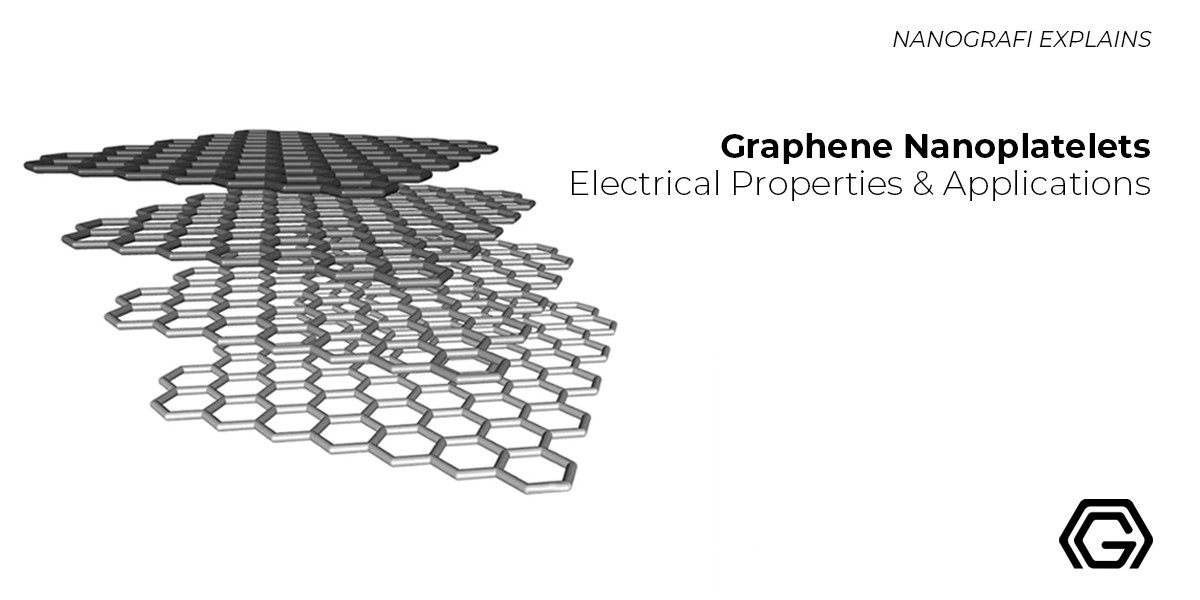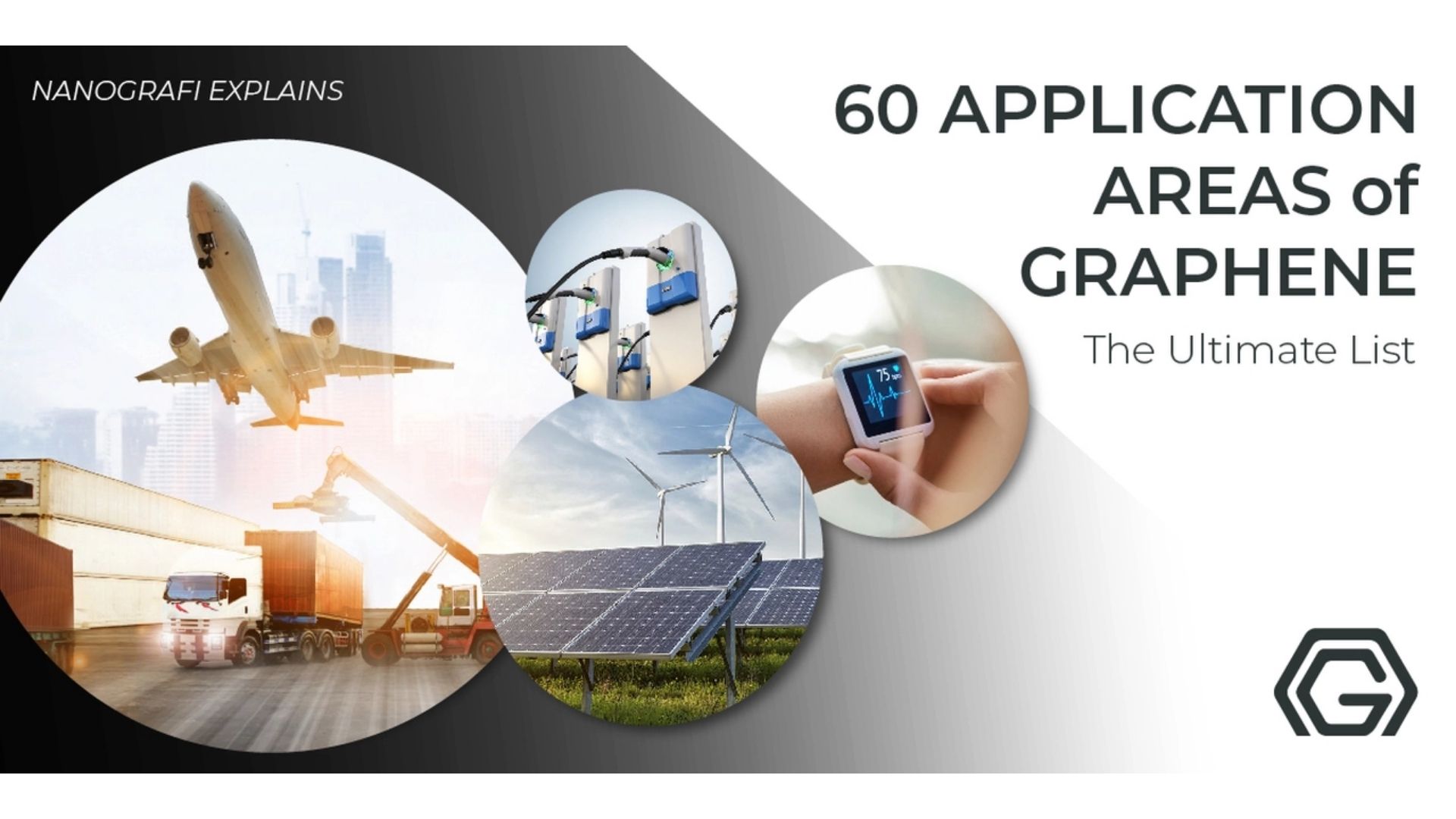Graphene Nanoplatelets Electrical Properties & Applications - Nanografi
Graphene nanoplatelets refer to the two-dimensional carbon structure materials possessing unique properties encompassing high specific surface area, high-strength high electrical conductivity, high thermal conductive and high modulus whose structure contains single or multi-layer graphite plane.
Graphene nanoplatelets which are regarded as hybrids between graphite and graphene are industrially available in the market currently.
What is Graphene Nanoplatelet?
Graphene nanoplatelet, pl.graphene nanoplatelets (GNPs), is nanoscale platelet-shaped particles that consist of a few to several layers of graphene, a single-atom-thick sheet of carbon atoms arranged in a hexagonal lattice. GNPs are typically produced by the exfoliation of graphite, a layered material, using mechanical or chemical methods.
The size and thickness of GNPs can vary depending on the method of production, but they typically have lateral dimensions ranging from a few to hundreds of nanometers and thicknesses of a few to tens of atomic layers. GNPs can have a high aspect ratio, with their length-to-width ratio reaching up to several thousand.
Graphene nanoplatelets have attracted special attention regarding their high aspect ratio, low cost, roughness, lightweight and planar structure. These unique and various properties have made them favorable agents to be applied for purposes and applications in rainforest plastic, materials for energy harvesting and electronic skin, flexible electronics, motion and structural sensing. Graphene nanoplatelets also have found applications in composite materials together with graphene.
Graphene Gold Rush
Graphene is a type of carbon allotrope that has a rigid hexagonal lattice structure with a thickness of just one carbon layer. This two-dimensional super crystalline structure can be rolled up to form one-dimensional carbon nanotubes or folded to create zero-dimensional fullerene. Interestingly, monolayer graphene can be stacked to produce graphite, the material from which it originated. Its unique properties have led to numerous applications in science and industry, and it was awarded the Nobel Prize in Physics in 2010. Unlike three-dimensional materials, graphene has a distinct electronic structure. In its pure form, the Fermi level is located at the connection points of six double cones, known as Dirac points, where the state density drops to zero. This results in low electrical conductivity. However, the Fermi level can be modified by applying an electric field to make graphene either electron-rich (n-doped) or porous (p-doped), depending on the polarity of the electric field. The doped graphene has potentially higher electrical conductivity than copper at room temperature.
Current Challenges in Graphene Mass-Production
Since the introduction of graphene to the world of science and technology, many research projects have concentrated on finding solutions to synthesize and produce defect-free graphene in industrial scales. Particularly, there are two noteworthy processes named liquid phase exfoliation of graphite and chemical vapor deposition on copper or metals in order to synthesize graphene and nearly desirable quality. Chemical vapor deposition based on the bottom-up approach leading to wide graphene films growing on top of metallic foils based on volatile carbon based precursors. Liquid phase exfoliation however, is considered as the physical top-down approach that singles out the graphene monolayer through graphite sonication processed through immersing it into solvents with low surface tension or water with surfactants. In this order single-layer graphene can be isolated taking the advantage of additional ultracentrifugation steps.
In effect, that pure graphene is not produced industrial scales and there is a still a lack of any reliable industrial techniques to separate the 2D crystals. The major constraints concerning graphene mass-production are the low rate of fabrication as well. Graphene nanoplatelets however, are a combination of low cost and outstanding physical properties as well as large-scale production. Graphene nanoplatelets are normally synthesized based on liquid phase exfoliation technique without any centrifugation step. Shear exfoliation, ball milling, wet-jet milling and exposure of acid-intercalated graphite to microwave radiation are other most common techniques. These methods yield a large amount of powders in terms of lateral size of the flakes, aspect ratio, defect concentration and thickness. Particularly, graphene nanoplatelets are composed of single and few layers of graphene that are mixed with graphite. In other words, they stand between graphite and graphene structurally. Materials that are based on graphene are categorized according to their lateral size, carbon to oxygen atomic ratio and thickness. Regarding the morphological characteristics, materials from the graphene family could be classified into single-layer graphene double-layer graphene and here in this context, graphene nano and micro platelets. Graphene nanoplatelets that are already available in the market as single layer and few layers and nanostructured graphite with their thickness ranging from 0.5 4 to 100 nm based on the same production batch process. It should be noted that graphite is could be categorized as a two-dimensional material as well when the number of its layers is less than 10.
To discover more about the wonder material graphene, you can read 60 Uses and Applications of Graphene.
Properties of Graphene Nanoplatelets
Graphene nanoplatelets possess exciting properties such as high aspect ratio, mechanical toughness, planner structure, low cost, electrical and thermal conductivity and light weight. They are specifically at the center of attention currently in combination with various nanostructured fillers including carbon black and carbon nanotubes, clays and metallic nanoparticles in the area of material science. Graphene nanoplatelets are interesting materials to design nanocomposites if they are capable of being included in the matrix of numerous polymers through melt compounding or solvents. The fact is Graphene nanoplatelets are not as expensive as carbon nanofibers and carbon nanotubes and are comparable with nanofillers with tubular morphology used for modifying mechanical properties of polymers. Furthermore, the electrical conductivity of graphene has been measured to be higher than that of graphene oxide.
Graphene Nanoplatelets Electrical Conductivity
Graphene nanoplatelets (GNPs) are a promising class of carbon-based materials with unique properties, including high surface area, high thermal conductivity, and exceptional mechanical strength. One of the most significant advantages of GNPs is their high electrical conductivity. The electrical conductivity of GNPs is determined by their ability to conduct electrical current through the material, which is primarily influenced by the number of graphene layers, size, and shape of nanoplatelets, and the presence of defects or impurities. The high electrical conductivity of GNPs arises due to the delocalization of electrons over the entire graphene surface, enabling facile movement of electrons. The electrical conductivity of GNPs can be further improved by modifying their surface chemistry, doping with other elements, or incorporating into a polymer matrix. The unique electrical conductivity properties of GNPs make them a highly sought-after material for various applications, including electronics, energy storage, and sensing. In the field of electronics, GNPs are used as conductive fillers in composites and coatings to improve their electrical properties. In the energy storage field, They are also used as an electrode material in batteries and supercapacitors due to their high conductivity and high surface area. Furthermore, GNPs are used as sensing materials in gas and biological sensors due to their high sensitivity to changes in the electrical environment. Therefore, the electrical conductivity of GNPs is a critical property that makes them highly attractive for various applications.
Graphene Nanoplatelets Applications
Graphene nanoplatelets (GNPs) are a highly versatile class of carbon-based nanomaterials that have attracted significant interest in recent years due to their unique properties. GNPs are composed of stacks of graphene sheets, with a high surface area, high thermal conductivity, and exceptional mechanical strength. Due to these properties, GNPs have found numerous applications in various fields, including electronics, energy storage, composites, and sensors. In electronics, GNPs are used as conductive additives in composites and coatings, as well as electrodes in transistors and solar cells. In energy storage, GNPs are used as an electrode material in batteries and supercapacitors. Moreover, GNPs are used as fillers in polymer composites to enhance mechanical and electrical properties, as well as in sensors for detecting gases, biomolecules, and other analytes. There are broad range of applications as graphene nanoplatelets have exceptional properties and there are ease of processing them into various forms, including films, coatings, and composites. This technical introduction will provide an overview of the various applications of GNPs and the underlying mechanisms behind their unique properties.
To discover more, you can read 3 Best Application Areas of Graphene Nanoplatelets.
Graphene Nanoplatelets-Based Applications in Flexible Electronics
Today, most electronic devices employ rigid conventional inorganic components in their design. Nevertheless, inorganic materials show drawbacks when they are applied in electronics industry which demands excellent flexibility as artificial electronic skin, portable energy harvesting devices, wearable and complaint electronics. On the other hand, the combination of conductive nanofillers and polymers mechanical properties turns out to be favorable enough as a way to create complaint conductive and flexible materials. More specifically, the research concerning the combination of silver nanoflakes exhibit exciting results in flexible electronics. But the problem is the idea faces limitations due to nano silver's high cost in large-scale production. At this point graphene nanoplatelets in particular and more generally carbon-based nanofillers emerge as promising alternative materials to be employed for flexible electronics based on their excellent flexibility load sheet resistance. A technique of manufacturing free-standing materials based on graphene nanoplatelets in a study involves fabricating flexible and lightweight graphene nanoplatelets paper were with excellent electrical conductivity. Graphene nanoplatelets which are a graphene-based binder-free porous film could be bent without suffering from any ruptures and have the quality to be impregnated with thermoplastic and thermoset polymers to improve in mechanical properties. After the impregnation step is completed, graphene nanoplatelets possess reduced electrical conductivity, sheet resistance, decreased thermal coupling with carbon fibers finally and adopt enhanced thermal properties.
Conclusion
Even though graphene emergence is considered as a breakthrough in material science in the 21st century, it still suffers from reliable mass-production methods, whereas other products from graphene family are available commercially and industrially. Particularly in this case, graphene nanoplatelets have attracted growing attention in their powder form due to their physicochemical properties which make them promising material for application in advanced nanocomposites.
To discover the latest articles in uses of graphene, you can visit Blografi.
References
3 best Application Areas of Graphene Nanoplatelets - Nanografi Nano Technology. (n.d.). Retrieved March 26, 2024, from https://nanografi.com/blog/3-best-application-areas-of-graphene-nanoplatelets/
60 Uses and Applications of Graphene – Nanografi - Nanografi Nano Technology. (n.d.). Retrieved March 26, 2024, from https://nanografi.com/blog/60-uses-and-applications-of-graphene-nanografi-/
Cataldi, P., Athanassiou, A. & Bayer, I. S. Graphene nanoplatelets-based advanced materials and recent progress in sustainable applications. Appl. Sci.8, (2018).
Geim, A. K. & Novoselov, K. S. The rise of graphene. Nat. Mater.6, 183–191 (2007).
Graphene Nanoplatelets: Properties and Applications - Nanografi Nano Technology. (n.d.). Retrieved March 26, 2024, from https://nanografi.com/blog/graphene-nanoplatelets-properties-and-applications/
How to Perform Dry and Liquid-Phase Exfoliation of Graphene - Nanografi Nano Technology. (n.d.). Retrieved March 26, 2024, from https://nanografi.com/blog/how-to-perform-dry-and-liquidphase-exfoliation-of-graphene/
Jhaa, G., Pancharatna, P. D., & Balakrishnarajan, M. M. (2023). Topological Impact of Delocalization on the Stability and Band Gap of Partially Oxidized Graphene. ACS Omega, 8(5), 5124–5135. https://doi.org/10.1021/ACSOMEGA.2C08169/ASSET/IMAGES/LARGE/AO2C08169_0017.JPEG
Kuan, C. F. et al. Characterization and properties of graphene nanoplatelets/XNBR nanocomposites. Polym. Polym. Compos.26, 59–67 (2018).
Metallic Nanoparticles: Top-Down and Bottom-up Approaches - Nanografi - Nanografi Nano Technology. (n.d.). Retrieved March 26, 2024, from https://nanografi.com/blog/metallic-nanoparticles-topdown-and-bottomup-approaches-nanografi/
Royal, T. H. E., Academy, S. & Sciences, O. F. compiled by the Class for Physics of the Royal Swedish Academy of Sciences Graphene. 50005, 0–10 (2010).
The Nobel Prize in Physics 2010 - Illustrated information - NobelPrize.org. (n.d.). Retrieved March 26, 2024, from https://www.nobelprize.org/prizes/physics/2010/illustrated-information/
Utilization of Graphene on Wearable Technologies - Nanografi Nano Technology. (n.d.). Retrieved March 26, 2024, from https://nanografi.com/blog/utilization-of-graphene-on-wearable-technologies/
Recent Posts
-
Advanced Materials for Unmanned Aerial Vehicle (UAV) Protection Against Laser
Consider a UAV on a critical mission, rendered inoperative by a sudden laser attack. With the increa …26th Jul 2024 -
Simulation and Modeling of Material Properties
Our world is composed of a dazzling array of materials, each with its own unique properties that dic …19th Jul 2024 -
Advanced Coatings for Superior Corrosion and Wear Resistance
Corrosion and wear pose significant challenges across various industries, leading to substantial eco …12th Jul 2024








